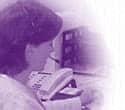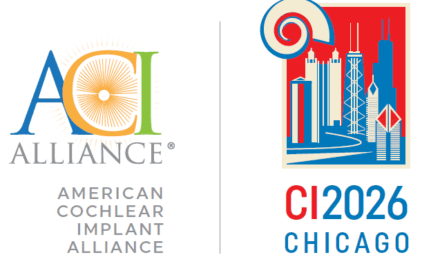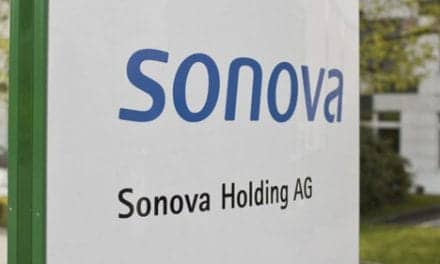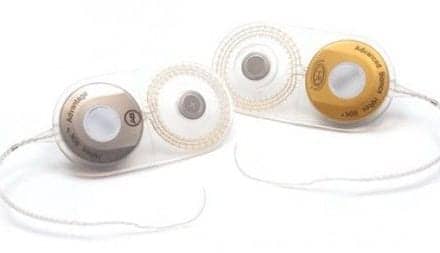
Bill Morgan loves to work, but his passion was almost lost to him because of his inability to hear the telephone calls that were the key component of his business. Bill has been gradually losing his hearing since childhood, and is now legally deaf. Raising the volume on his telephone did nothing to make the voices on the other end intelligible to him. “It was something I didn’t want to admit,” he says, adding that this caused him to stop answering most phone calls. “On voice mail I could hear the sounds, I could make out, say, 60% or 70% in a good conversation, but numbers, letters, addresses, forget it.” The loss of his key business tool brought Bill to the edge of retiring from his career as an entrepreneur. The loss of telephonic communication also affected Bill’s personal life. He was no longer able to speak to his four children—all of whom lived away from home—and cast his wife, Alice, into another role: telephone translator.

Then, on the same day in 1995, Bill and Alice both learned of an assistive listening device that would allow Bill to continue his business career—Hearing Aid Telephone Interconnect Systems® (HATIS). Though the Morgans were intrigued by the technology, Bill was skeptical. “I figured here’s another gimmick, another thing that’s overhyped, but I can’t afford not to try it,” he says.
When he received the headphone device, Bill’s skepticism remained when he saw the unit was of dubious quality. Then he plugged it into his phone and made a call. “It was a revelation to me,” he says. “I turned my business life around overnight, in the space of 5 minutes, by putting it on my head.”
Alice adds that HATIS did more than rescue Bill’s business. “This not only saved his career, it saved him as a person,” she says. “It allowed him to remain viable, and to play every day. Most people go to work, my husband has never worked a day in his life. He considers work play. He is so passionate [about it], and he loves to work.”
The device also relieved Alice of her position as mediator of family telephone calls, a role she relinquished when the Morgans’ son, Benjamin, called shortly after Bill received his HATIS.
“I was mischievous and told Benjamin I was too busy to relay the questions, and to talk to his dad, “ she says. “Our son replied, ‘No, this is really important and Dad won’t hear me.’ I cut him off and gave the portable landline phone to his father. I watched through the kitchen window where I was baking, my husband pinching off dead flowers in our backyard and talking to our son. I witnessed laughter, a father and son having a wonderful talk, and, when my husband hung up the phone, he was wiping away tears—happy tears.”
The Telecoil Inductive Coupler
This “miracle” was achieved by using a fairly simple technology. The HATIS consists of a telecoil (t-coil) inductive coupler, which is plugged directly into the user’s telephone—cellular or landline—or other audio or communication devices. It is worn next to the user’s hearing aid, which must be turned to the telecoil mode in order to receive a signal from the device. In this arrangement, the hearing aid acts as a receiver, and, because the sound is traveling directly from the telephone, television, or stereo into the HATIS and not the air, the signal does not become distorted, making the sound clearer and voices more intelligible.
The first HATIS devices were designed exclusively for use with BTEs, but now there are models available for users of ITEs and cochlear implants with t-coil capability. The HATIS was developed by Jo Waldron in the late 1980s. Born with severe hearing loss, Waldron discovered the underlying scientific principle that is at the heart of HATIS, by accident, as a child when she was playing with a U-shaped magnet, slipping it around her body aid and finding that she could hear everyday sounds clearly for the first time. As an adult, Waldron invested years in researching the phenomenon and developed the HATIS device.
The Morgans’ involvement with HATIS did not stop at being satisfied customers. They had invested in the company. Their role changed in 1999, when Alice purchased the company from Waldron, whose lack of business experience and failing health had brought the company to the brink of ruin. The decision was not just a business move, but had personal motives as well. Alice wanted to make sure that Bill would still have access to the lifesaving technology. But it was also a risk—one jeopardizing carefully made plans for a comfortable retirement.
“I believe God opens doors to us,” says Alice. “The memory of my husband speaking to our son could not be ignored. I thought of the 30 to 40 million Americans alone who were like my husband—who needed or wanted to work, who missed being able to talk on the phone to family and friends, who dealt with the day-to-day frustration and stress of not being able to do the simplest things like call and order a pizza, make a doctor’s appointment, call for information. Then, I thought of all the people who had no protection if their car broke down and had no cell phone to use or, worse, could not call 911 for information on what to do if their spouse or child were injured.”
Purchasing the Company
The purchase of the company, which included all of the HATIS patents, came with another price for Alice. Although Waldron and her partner had confidence in Alice, as a condition of the sale, she had to agree to run HATIS full-time. This meant Alice had to give up her successful investment career. She continues to oversee a handful of accounts part-time and employs a staff person to help with transfer of accounts and other financial matters for her investment clientele.
A big advantage of the HATIS for users is that it does not require batteries. “We do not want to add additional cost for our customers with replacing batteries,” says Alice. “But of greater concern, [we do not want] our products to stop working at the worst possible time because of a dead battery.”
The HATIS Corporation was born in January 1999. Alice became the president of the new company and Bill became CEO. Operations were moved from Colorado to Walnut Creek, Calif. Currently, HATIS has a single location and 16 employees.
Before HATIS could begin operating at full capacity, the quality problems, which had plagued the original company, had to be solved. Alice pushed to have it manufactured and assembled by an American company. She found a company that could guarantee quality with Minnesota Wire & Cable in St Paul, Minn, which had experience manufacturing medical equipment. It also shares Alice’s world view. “If you visit [Minnesota Wire & Cable], you will see posted throughout the company a sign that, in part, states, ‘What we do here affects the lives of people,’ and goes on to enforce the critical need to make the very best product humanly possible,” she says.
Marketing received a serendipitous boost when Verizon Communications bought several HATIS units for its employees, a move that was so successful the company entered into a partnership with HATIS to carry the unit in all of its 1,200 retail outlets. Now, Verizon Communications actively markets the product. Several other companies also carry HATIS including Oaktree Products and HITEC Group International Inc.
Though the partnership with Verizon Communications was a marketing coup, HATIS initially found little interest from audiologists. “It’s an unfortunate fact of life that many audiologists, as much as they would like to [carry HATIS], just cannot do it because they are a one or two person show,” says Alice. “They have bills to pay. They have to make a living. Also, in the past [they’ve been sold on a product that was supposed to be] the next best thing to sliced bread and found out that it’s some stupid gadget. That’s something we understand and recognize.” HATIS is currently working with its various distributors to educate audiologists about the benefits of the device.
Customer Profiles
HATIS has three customer profiles: children, Baby Boomers, and the elderly. Each has its particular needs, which means that HATIS’ products must fulfill a wide variety of requirements. “All of our customers have different types of hearing loss, some don’t hear the lower decibels, some don’t hear the higher decibels,” says Alice. “Our headset is designed to pick and choose what is most important and feeds it directly into the hearing aid.
“When I bought the company and the patents, there was just obviously the key patent of why HATIS works and they had only a solo device—meaning for one ear. They didn’t even have one for both ears. So, we have developed a line trying to keep in mind every possible condition—from [problems affecting] the working professional to the mom to the junior high/high school/college student. We are working with many companies that have sent us their products to make sure that HATIS can be utilized with them. I’m not going to say that all these companies that we’re working with are in this strictly because they care. Obviously, they want to make money. They also do care about wanting to be able to have their products work for everyone.”
Developing New Products
Bill takes special interest in the development of new products. He both proposes new ideas that he passes to the engineering staff at Minnesota Wire & Cable, and acts as the test pilot for every new product. After the initial tests, the new product is passed to a group of HATIS users who will field test the product—and receive a free one if it is successful. As part of the testing and development phase, each product is also put through a battery of durability tests to make sure that it will stand up to everyday wear and tear.
The Morgans also involve HATIS customers in coming up with new ideas, and sometimes customers inspire innovations or bring attention to particular needs. “We have a large constituent of pilots who use our products, but need it for the cockpit [communications system], which requires splitting the main wire of our products,” says Alice. “Many customers have tampered with their HATIS products endeavoring to find a solution [for their particular needs].”
The most popular unit is the single-ear Freedom, which accounts for about half of HATIS’ sales. However, Bill expects the new Producer model for ITEs (which already accounts for 25% of sales) will supplant the older unit because of the growing popularity of ITEs with the customer base.
A product that makes it through the Bill-customer-testing gauntlet does not guarantee ultimate success. Bill and Alice constantly evaluate the performance of each model in the HATIS line. “We’ve found that our sales of those units that have dual versions, meaning you can use both ears, are in the 2% to 5% category and we’re thinking about knocking out at least one of those because we find that people who buy HATIS for cell phone use really don’t want to use two ears,” says Bill. “We’ll probably narrow the line a little bit because we’re not selling that much in the dual version of the cell phone model.”
But there are future models and innovations waiting in the wings, including one to help hearing aid users hear films in movie theaters. “Our goal is to be the default brand, to be the go-to brand for anyone who has a hearing loss and wants to use or needs to use a headset,” says Bill.
For Alice, buying the company has been well worth the risk. “This was the best decision I ever made in my entire life, because I haven’t saved the world, I haven’t changed the world—well, not enough—but this company has given options and choices and freedom and safety to so many millions of people,” she says. “What I have taken away from doing this is priceless.”
Mark Travis is a contributing writer for Hearing Products Report.





